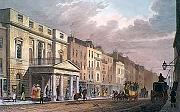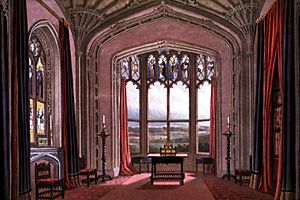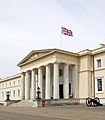James Wyatt facts for kids
Quick facts for kids
James Wyatt
|
|
|---|---|
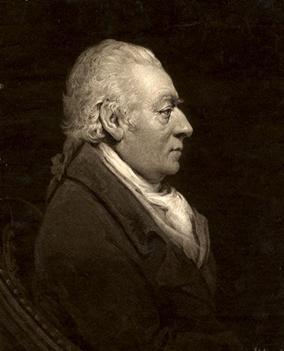
Mezzotint after a portrait by Wyatt's son Matthew Cotes Wyatt
|
|
| Born | 3 August 1746 Blackbrook Farm, Weeford, Staffordshire, England
|
| Died | 4 September 1813 (aged 67) 2 miles east of Marlborough in carriage accident
|
| Nationality | English |
| Occupation | Architect |
| Spouse(s) | Rachel Lunn |
| Children | 4 sons, including Benjamin Dean, Matthew Cotes, Philip |
| Buildings | Fonthill Abbey |
James Wyatt (born August 3, 1746 – died September 4, 1813) was a famous English architect. He was known for his work in two main styles: neoclassical and neo-Gothic. He was a big rival of another famous architect, Robert Adam. James Wyatt became a member of the Royal Academy in 1785 and was even its president for a year, from 1805 to 1806.
Contents
Early Life and Training
James Wyatt was born on August 3, 1746, in a place called Weeford, near Lichfield, in Staffordshire, England.
Studying Architecture in Italy
Wyatt spent six years in Italy, from 1762 to 1768. He traveled with Richard Bagot, who worked for an important English official in Venice. In Venice, Wyatt learned how to draw architectural plans and paint from a teacher named Antonio Visentini.
Later, in Rome, he carefully measured and drew the huge dome of St. Peter's Basilica. This was a very difficult task! He had to lie on his back on a ladder, high up in the air, to get the measurements right.
Becoming a Famous Architect
When Wyatt returned to England, he quickly became very successful. He was chosen to design a new building in Oxford Street, London, called the Pantheon. It was meant to be a winter entertainment hall, like a fancy indoor park.
The Pantheon: Wyatt's Big Break
His brother, Samuel, helped him get the job, even though James was young and not well-known. When the Pantheon opened in 1772, everyone loved it. A famous writer, Horace Walpole, even said it was "the most beautiful building in England."
The outside of the Pantheon wasn't special, but the inside was amazing. It had a large domed hall with galleries and curved ends. This design was new for assembly rooms and made Wyatt instantly famous. He showed his design at the Royal Academy and soon started getting many private jobs. In 1770, at just 26 years old, he became an Associate of the Royal Academy.
People liked his polite manners, and he made many friends and important clients. There was even a rumor that he might leave England to work for Catherine II of Russia. But a group of English noblemen offered him a lot of money to stay and work for them.
Wyatt's Neoclassical Houses
Some of his most important neoclassical country houses include:
- Heaton Hall near Manchester (1772)
- Heveningham Hall in Suffolk (around 1788–99)
- Castle Coole in Ireland
- Packington Hall in Staffordshire
- Dodington Park in Gloucestershire
In 1785, Wyatt became a full member of the Royal Academy.
Later Work and Official Roles
Later in his career, Wyatt made changes to Frogmore for Queen Charlotte. He also became the Surveyor-General of the Works, a very important government job. Around 1800, he was asked to make changes to Windsor Castle. He also designed a "strange castellated palace" at Kew for King George III in 1802. This palace was special because it used a lot of cast iron in its construction.
Between 1805 and 1808, Wyatt redesigned West Dean House in West Dean, West Sussex. This building is unique because it's made entirely of flint stone, even around the doors and windows, where stone would normally be used.
Important Government Positions
In 1776, Wyatt became the Surveyor to Westminster Abbey, responsible for its upkeep. In 1782, he also became the Architect of the Board of Ordnance, which managed military buildings. When Sir William Chambers died in 1796, Wyatt took over his role as Surveyor General and Comptroller of the Works. This made him the most important architect in the country.
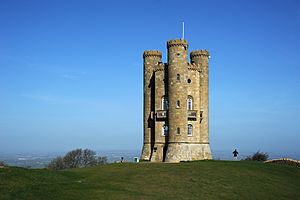
Wyatt had so many jobs that he sometimes struggled to give enough attention to all his clients. He was known for taking on many projects but sometimes neglecting them. This led to changes in how government building projects were managed after he died.
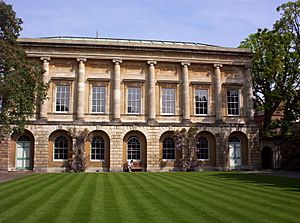
Wyatt was a very talented designer, but his style wasn't always unique. When he started, the Adam brothers were very popular, and Wyatt often copied their interior designs. He even told King George III that he had to follow the "corrupted taste" of the Adams because that's what people wanted. Much of his classical work used decorations from Coade stone and Etruscan-style medallions.
Wyatt's Gothic Style Work
Wyatt became even more famous for his Gothic designs. Many architects at the time would add Gothic features like battlements and pointed windows to their buildings. But Wyatt went further. He made his Gothic buildings look very dramatic and picturesque, adding towers and spires.
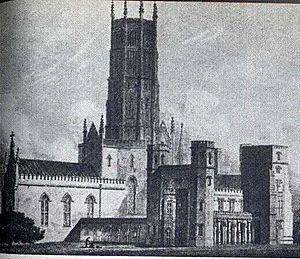
His most famous Gothic works include Fonthill Abbey and Ashridge. These houses showed how romantic and exciting Gothic architecture could be. Even though some details weren't perfectly accurate to medieval times, these buildings were very important in the Gothic revival movement in England. People at the time said Wyatt had "brought back the long forgotten beauties of Gothic architecture."
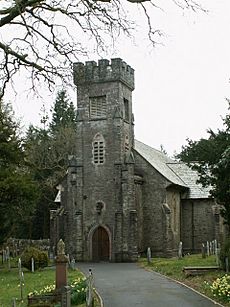
Wyatt also worked on restoring several cathedrals, like Salisbury, Durham, Hereford, and Lichfield. He believed these old churches should look uniform in style and be free of old screens or monuments. His work on these cathedrals was criticized by some, but he also did important repair work, especially at Westminster Abbey.
In 1802, Wyatt built a new house for the Earl of Bridgewater at Ashridge in Hertfordshire. This building is now a very important Grade I listed building. In 1803, he designed Saint Michel's Hafod Church in Ceredigion, Wales.
Family and Death
James Wyatt died on September 4, 1813. He was in a carriage accident while traveling with his friend, Christopher Bethell-Codrington, near Marlborough Downs. He was buried in Westminster Abbey.
He had a wife and four sons. Two of his sons, Benjamin Dean and Philip, also became well-known architects. His second son, Matthew Cotes, became a famous sculptor.
Students and Assistants
Wyatt taught many students who later became architects themselves. Some of them include William Atkinson and John Foster, junior. His main assistant was Joseph Dixon, who worked with him from the time the Pantheon was built.
Notable Architectural Works
Here are some of the buildings James Wyatt designed or worked on:
Public Buildings
- The Pantheon, London, 1770–1772 (now gone)
- Christ Church, Oxford, parts of the Canterbury Quad, 1773–83
- Radcliffe Observatory, Oxford, 1776–94
- Holywell Music Room, Oxford, interior changes 1780
- Liverpool Town Hall, interiors 1783–1813
- Royal Military Academy, Woolwich, 1796–1805
- Palace of Westminster, restoration of the House of Lords 1800–1813 (burnt down in 1834)
- Ripon Town Hall, Yorkshire, 1801
- The Royal Military College, Sandhurst, Berkshire, 1807–12
Churches
- St. James Church, Milton Abbas, Dorset, 1774–86
- St. George's Chapel, Windsor Castle, changes 1787–1790
- Salisbury Cathedral, restoration work 1787–93
- Lichfield Cathedral, restoration 1788–95
- Hereford Cathedral, restoration 1788–97
- Westminster Abbey, London, restoration work 1803
London Houses
- 11–15 Portman Square, London, 1774
- 1 Foley Place, London, 1783 (Wyatt's own house, now gone)
- Queen's House (now Buckingham Palace), London, changes 1793
- New Palace Kew, London, 1802–11 (never finished, now gone)
New Country Houses
- Heaton Hall, Lancashire, 1772
- Sheffield Park, Sussex, 1776
- Castle Coole, County Fermanagh, 1790-1798
- Frogmore House, Berkshire, 1792
- Fonthill Abbey, Wiltshire, 1796–1813
- Dodington Park, Gloucestershire, 1798–1808
- Norris Castle, Isle of Wight, 1799
- Belvoir Castle, Leicestershire, 1801–1813
- Ashridge, Hertfordshire, 1808–1813
Garden Buildings and Follies
- Folly, Temple Island, 1771
- Cobham Hall, Kent, Darnley Mausoleum, 1783
- Broadway Tower, a tall tower for Lady Coventry, 1794
- Panorama Tower, Croome Park, Worcestershire, 1801
Alterations to Country Houses
- Cobham Hall, Kent, changes and additions, 1771–1812
- Heveningham Hall, interiors and orangery, 1776–84
- Ragley Hall, Warwickshire, changes and interiors 1780
- Plas Newydd, Anglesey, changes and enlargements 1783–1811
- Goodwood House, Sussex, enlargements, 1787–1806
- Powderham Castle, addition of music room 1788
- Windsor Castle, Berkshire, changes and interiors 1796–1800
- Wilton House, Wiltshire, changes 1801–11
Images for kids
-
Bath Lodge, Dodington Park
-
Norris Castle, Isle of Wight
-
Castle Coole, Enniskillen
See also
 In Spanish: James Wyatt para niños
In Spanish: James Wyatt para niños
- Wyatt family


